Comparison of Mechanical and Crack-Healing Properties of PE-PVA Hybrid Fiber-Reinforced SHCCs in Natural and Underwater Conditions
Abstract
:- Effects of environmental conditions on properties of SHCC were investigated.
- SHCC exposed to natural environment showed slightly lower mechanical properties.
- SHCC exposed to natural environment showed slight crack-sealing performance.
- Both SHCCs under different conditions showed similar trends in tensile behavior at reloading.
1. Introduction
2. Experimental Program
2.1. Materials and Mixture Proportions
2.2. Specimen Preparation
2.3. Density and Mechanical Measurements
2.4. Crack-Healing Assessment
3. Results and Discussion
3.1. Mechanical Properties
3.2. Crack Healing Performance
3.3. Stiffness Recovery
3.4. Tensile Properties at Post-Healing
4. Conclusions
- At 28 days of age, the compressive strength of the M-O mixture was 10% lower than that of the M-W mixture, which indicates that underwater conditions were better than natural conditions outdoors at improving the compressive strength of SHCC.
- Under static tension load, M-W and M-O mixtures showed ultra-ductile behavior, with tensile strain capacity of approximately 8% at 28 days of age. It was observed that the tensile strength and tensile strain capacity of the M-O mixture were lower than those of the M-W mixture by 4% and 3%, respectively.
- Over 28 healing days, the M-W mixture showed complete crack healing phenomena, with healing threshold of crack width of approximately 60 µm, while the M-O mixture had very limited crack healing capacity. Both M-W and M-O mixtures showed potential for stiffness recovery; however, the stiffness recovery of the M-O mixture was 15%p lower than that of the M-W mixture. Accordingly, the natural condition is not sufficient for high crack-healing of SHCC, while the underwater condition plays an essential role in facilitating excellent crack-healing performance.
- The M-W and M-O mixtures showed clear strain-hardening responses in the re-loading stage. After crack-healing, the tensile strengths of the two mixtures were unchanged; however, their tensile strain capacities were relatively reduced compared to those at pre-healing.
Author Contributions
Funding
Institutional Review Board Statement
Informed Consent Statement
Data Availability Statement
Conflicts of Interest
References
- Gagg, C.R. Cement and concrete as an engineering material: An historic appraisal and case study analysis. Eng. Fail. Anal. 2014, 40, 114–140. [Google Scholar] [CrossRef]
- Herbert, E.N.; Li, V.C. Self-Healing of Microcracks in Engineered Cementitious Composites (ECC) Under a Natural Environment. Materials 2013, 6, 2831–2845. [Google Scholar] [CrossRef] [PubMed]
- Li, X.; Lv, X.; Zhou, X.; Meng, W.; Bao, Y. Upcycling of waste concrete in eco-friendly strain-hardening cementitious composites: Mixture design, structural performance, and life-cycle assessment. J. Clean. Prod. 2022, 330, 129911. [Google Scholar] [CrossRef]
- Kim, Y.-S.; Tran, T.Q.; Kang, G.-O.; Do, T. Stabilization of a residual granitic soil using various new green binders. Constr. Build. Mater. 2019, 223, 724–735. [Google Scholar] [CrossRef]
- Li, V.C. Engineered Cementitious Composites (ECC): Bendable Concrete for Sustainable and Resilient Infrastructure; Springer: Berlin/Heidelberg, Germany, 2019. [Google Scholar]
- Yang, Y.; Yang, E.-H.; Li, V.C. Autogenous healing of engineered cementitious composites at early age. Cem. Concr. Res. 2011, 41, 176–183. [Google Scholar] [CrossRef]
- Yang, Y.; Lepech, M.D.; Yang, E.-H.; Li, V.C. Autogenous healing of engineered cementitious composites under wet–dry cycles. Cem. Concr. Res. 2009, 39, 382–390. [Google Scholar] [CrossRef]
- Qiu, J.; Tan, H.S.; Yang, E.-H. Coupled effects of crack width, slag content, and conditioning alkalinity on autogenous healing of engineered cementitious composites. Cem. Concr. Compos. 2016, 73, 203–212. [Google Scholar] [CrossRef]
- Zhang, D.; Wu, H.; Li, V.C.; Ellis, B.R. Autogenous healing of Engineered Cementitious Composites (ECC) based on MgO-fly ash binary system activated by carbonation curing. Constr. Build. Mater. 2020, 238, 117672. [Google Scholar] [CrossRef]
- Qian, S.; Zhou, J.; Schlangen, E. Influence of curing condition and precracking time on the self-healing behavior of Engineered Cementitious Composites. Cem. Concr. Compos. 2010, 32, 686–693. [Google Scholar] [CrossRef]
- Zhang, Z.; Zhang, Q. Self-healing ability of Engineered Cementitious Composites (ECC) under different exposure environments. Constr. Build. Mater. 2017, 156, 142–151. [Google Scholar] [CrossRef]
- Sisomphon, K.; Copuroglu, O.; Koenders, E. Effect of exposure conditions on self healing behavior of strain hardening cementitious composites incorporating various cementitious materials. Constr. Build. Mater. 2013, 42, 217–224. [Google Scholar] [CrossRef]
- Zhang, S.; Duque-Redondo, E.; Kostiuchenko, A.; Dolado, J.S.; Ye, G. Molecular dynamics and experimental study on the adhesion mechanism of polyvinyl alcohol (PVA) fiber in alkali-activated slag/fly ash. Cem. Concr. Res. 2021, 145, 106452. [Google Scholar] [CrossRef]
- Nguyễn, H.H.; Choi, J.-I.; Song, K.-I.; Song, J.-K.; Huh, J.; Lee, B.Y. Self-healing properties of cement-based and alkali-activated slag-based fiber-reinforced composites. Constr. Build. Mater. 2018, 165, 801–811. [Google Scholar] [CrossRef]
- Nguyễn, H.H.; Choi, J.-I.; Kim, H.-K.; Lee, B.Y. Effects of the type of activator on the self-healing ability of fiber-reinforced alkali-activated slag-based composites at an early age. Constr. Build. Mater. 2019, 224, 980–994. [Google Scholar] [CrossRef]
- Nguyễn, H.H.; Choi, J.-I.; Kim, H.-K.; Lee, B.Y. Mechanical properties and self-healing capacity of eco-friendly ultra-high ductile fiber-reinforced slag-based composites. Compos. Struct. 2019, 229, 111401. [Google Scholar] [CrossRef]
- Nguyễn, H.H.; Choi, J.-I.; Park, S.-E.; Cha, S.L.; Huh, J.; Lee, B.Y. Autogenous healing of high strength engineered cementitious composites (ECC) using calcium-containing binders. Constr. Build. Mater. 2020, 265, 120857. [Google Scholar] [CrossRef]
- Yu, K.; Zhu, H.; Hou, M.; Li, V.C. Self-healing of PE-fiber reinforced lightweight high-strength engineered cementitious composite. Cem. Concr. Compos. 2021, 123, 104209. [Google Scholar] [CrossRef]
- Zhang, D.; Yu, J.; Wu, H.; Jaworska, B.; Ellis, B.R.; Li, V.C. Discontinuous micro-fibers as intrinsic reinforcement for ductile Engineered Cementitious Composites (ECC). Compos. Part B Eng. 2020, 184, 107741. [Google Scholar] [CrossRef]
- Pourfalah, S. Behaviour of engineered cementitious composites and hybrid engineered cementitious composites at high temperatures. Constr. Build. Mater. 2018, 158, 921–937. [Google Scholar] [CrossRef]
- Tinoco, M.P.; Silva, F.D.A. On the mechanical behavior of hybrid fiber reinforced strain hardening cementitious composites subjected to monotonic and cyclic loading. J. Mater. Res. Technol. 2021, 11, 754–768. [Google Scholar] [CrossRef]
- Ali, M.; Soliman, A.; Nehdi, M. Hybrid-fiber reinforced engineered cementitious composite under tensile and impact loading. Mater. Des. 2017, 117, 139–149. [Google Scholar] [CrossRef]
- Huang, B.-T.; Weng, K.-F.; Zhu, J.-X.; Xiang, Y.; Dai, J.-G.; Li, V.C. Engineered/strain-hardening cementitious composites (ECC/SHCC) with an ultra-high compressive strength over 210 MPa. Compos. Commun. 2021, 26, 100775. [Google Scholar] [CrossRef]
- Choi, J.-I.; Nguyễn, H.H.; Park, S.-E.; Ranade, R.; Lee, B.Y. Effects of fiber hybridization on mechanical properties and autogenous healing of alkali-activated slag-based composites. Constr. Build. Mater. 2021, 310, 125280. [Google Scholar] [CrossRef]
- Suryanto, B.; Wilson, S.A.; McCarter, W.J.; Chrisp, T.M. Self-healing performance of engineered cementitious composites under natural environmental exposure. Adv. Cem. Res. 2016, 28, 211–220. [Google Scholar] [CrossRef]
- Lương, Q.-H.; Nguyễn, H.H.; Choi, J.-I.; Kim, H.-K.; Lee, B.Y. Effects of crumb rubber particles on mechanical properties and sustainability of ultra-high-ductile slag-based composites. Constr. Build. Mater. 2021, 272, 121959. [Google Scholar] [CrossRef]
- ASTM C109/C109M-21; Standard Test Method for Compressive Strength of Hydraulic Cement Mortars (Using 2-in. or [50-mm] Cube Specimens). ASTM: Washington, DC, USA, 2007.
- JSCE. Recommendations for Design and Construction of High Performance Fiber Reinforced Cement Composites with Multiple Fine Cracks; Japan Society of Civil Engineers: Tokyo, Japan, 2008. [Google Scholar]
- Zhu, H.; Zhang, D.; Wang, T.; Wu, H.; Li, V.C. Mechanical and self-healing behavior of low carbon engineered cementitious composites reinforced with PP-fibers. Constr. Build. Mater. 2020, 259, 119805. [Google Scholar] [CrossRef]
- ACI Committee. Building Code Requirements for Structural Concrete (ACI 318-08) and Commentary; American Concrete Institute: Farmington Hills, MI, USA, 2008. [Google Scholar]
- Kim, S.-H.; Shah, S.H.A.; Woo, S.-K.; Chu, I.; Sim, C. Probability-Based Crack Width Estimation Model for Flexural Members of Underground RC Box Culverts. Appl. Sci. 2022, 12, 2063. [Google Scholar] [CrossRef]
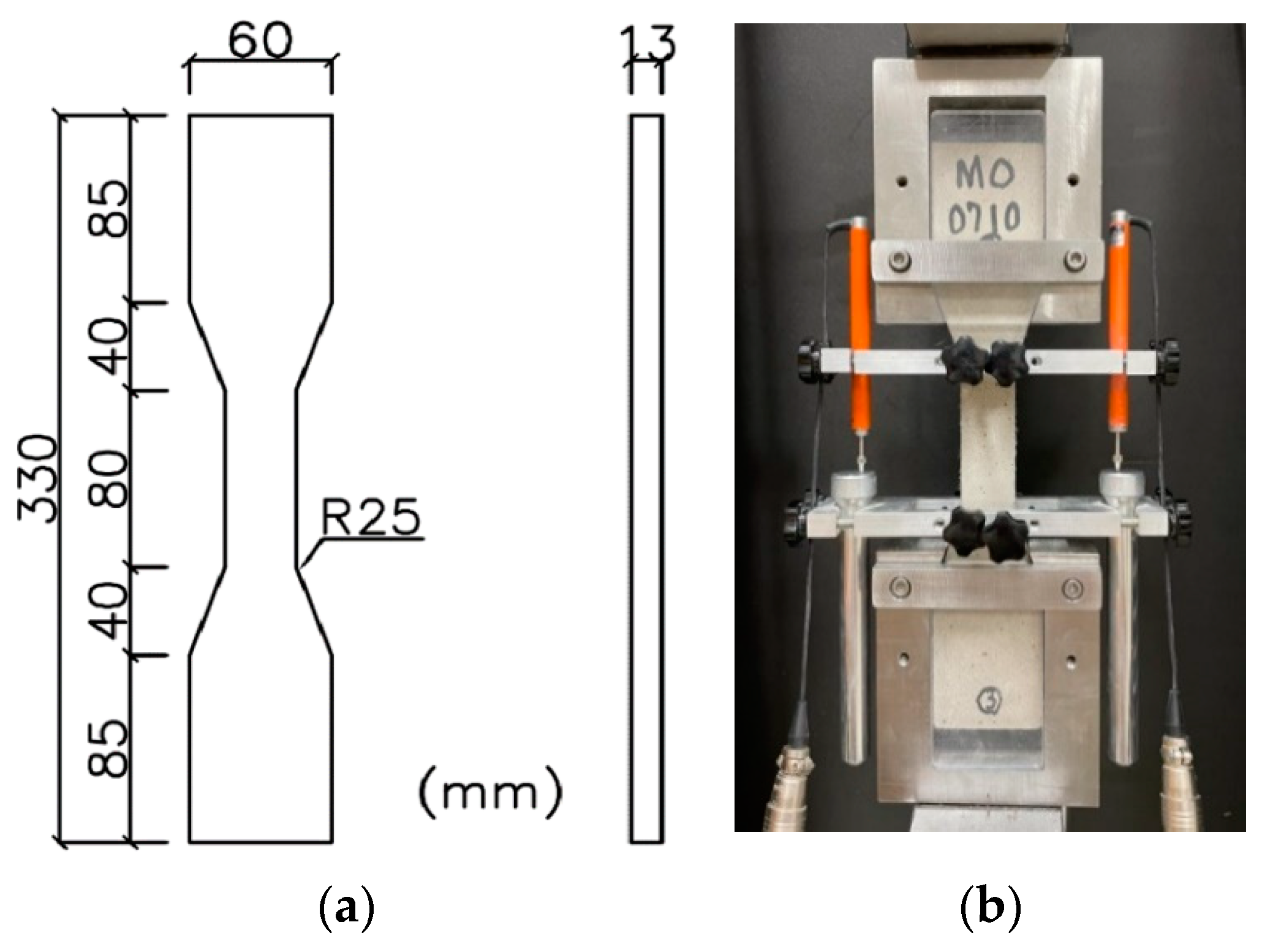

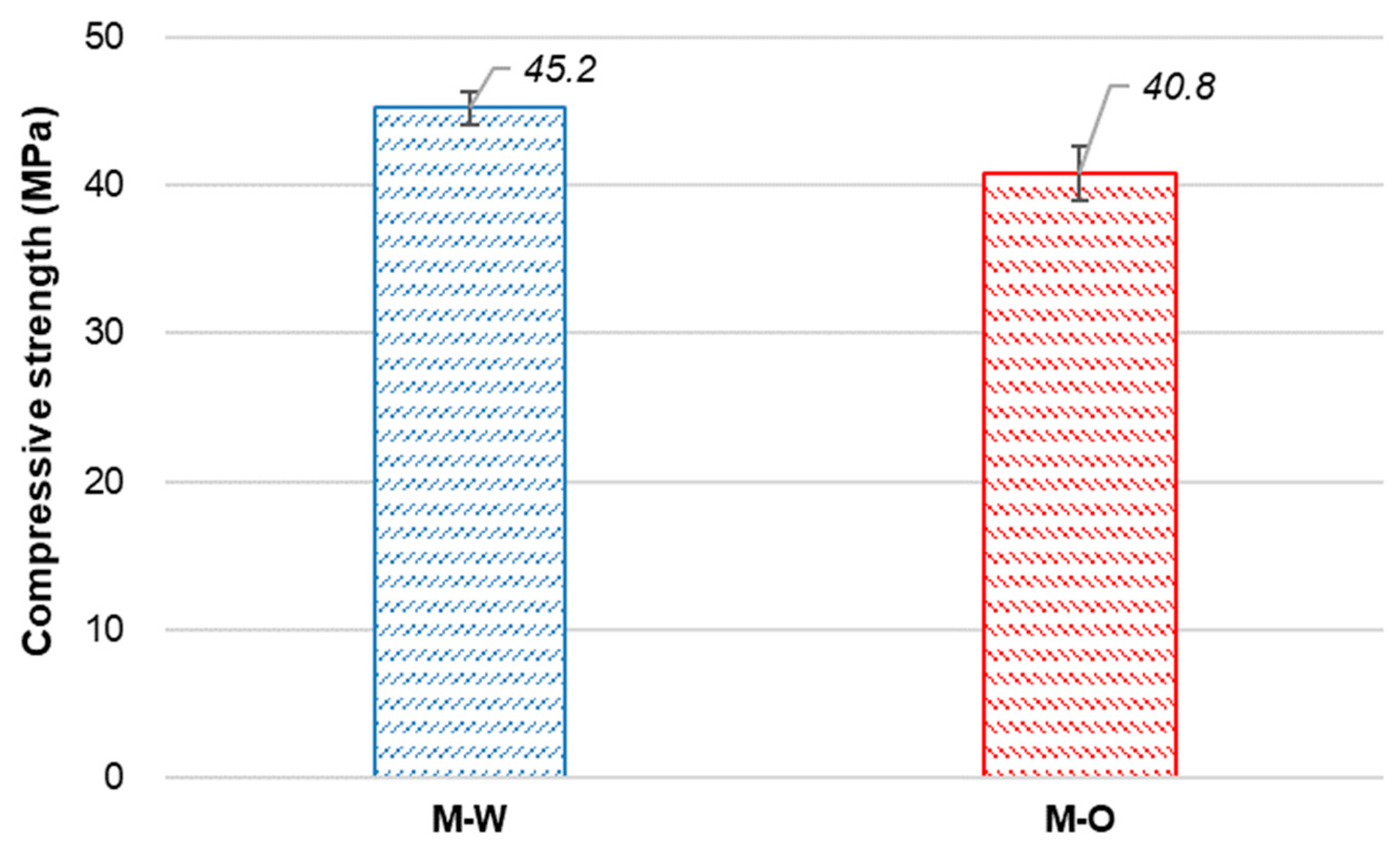
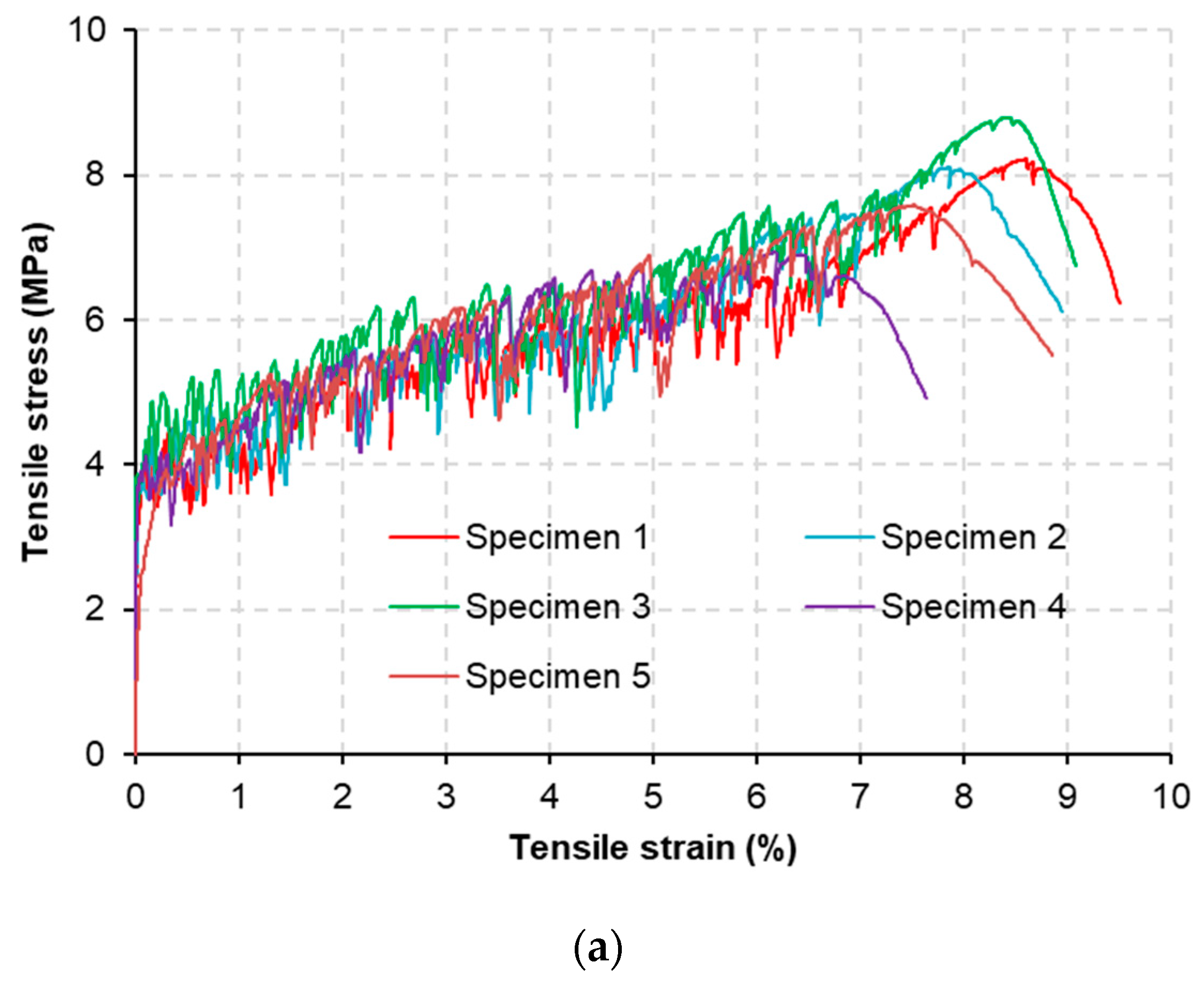
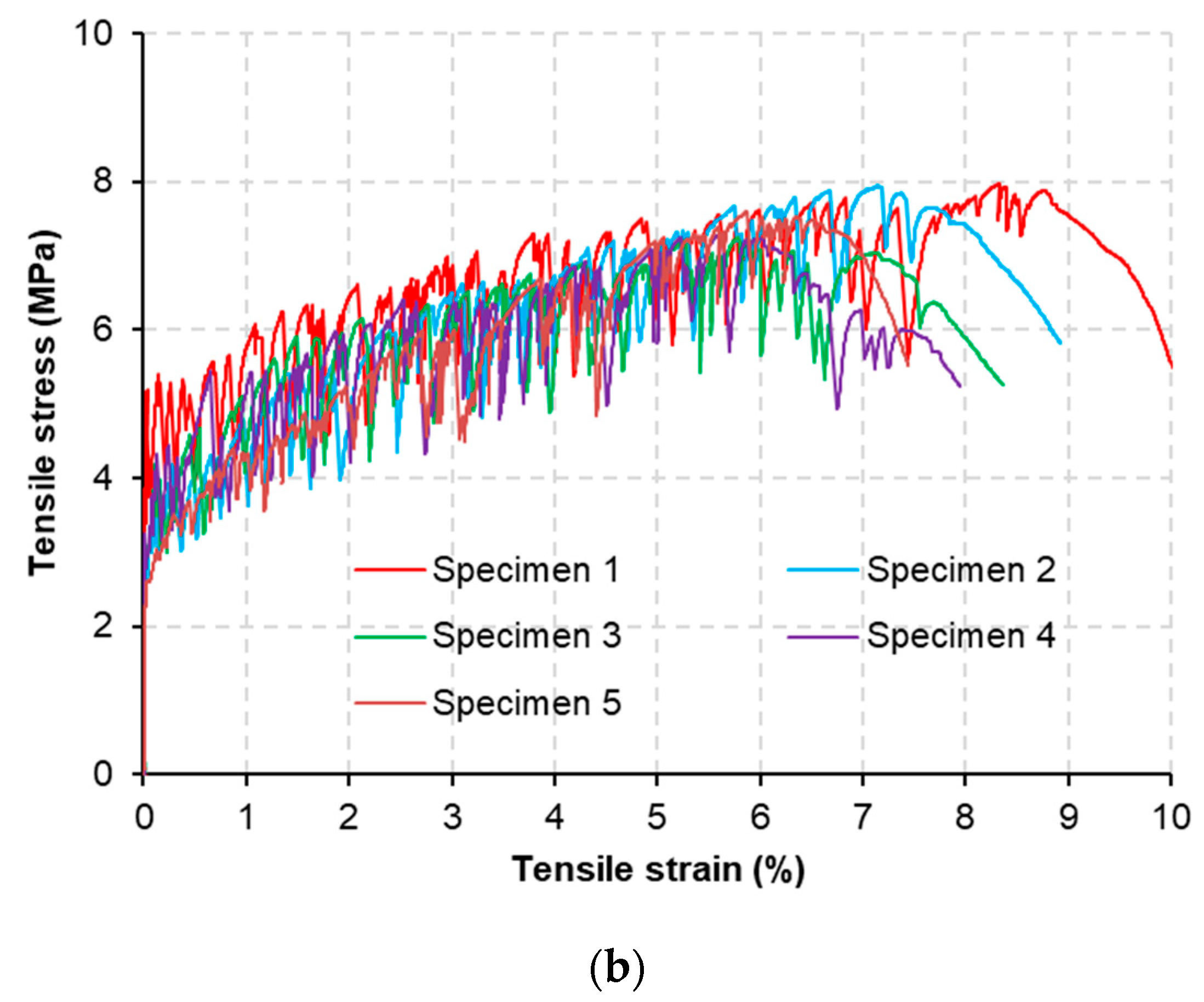
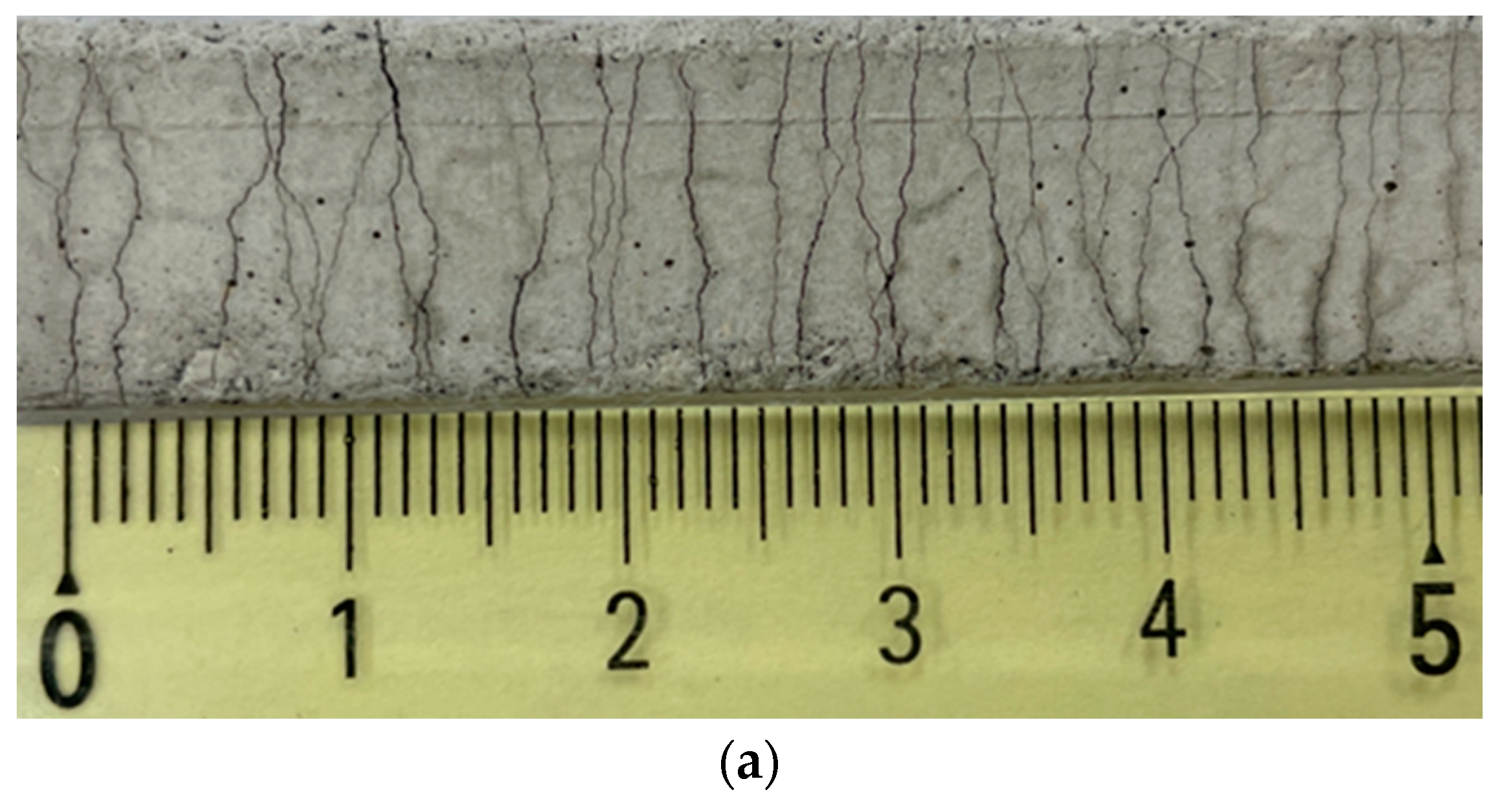
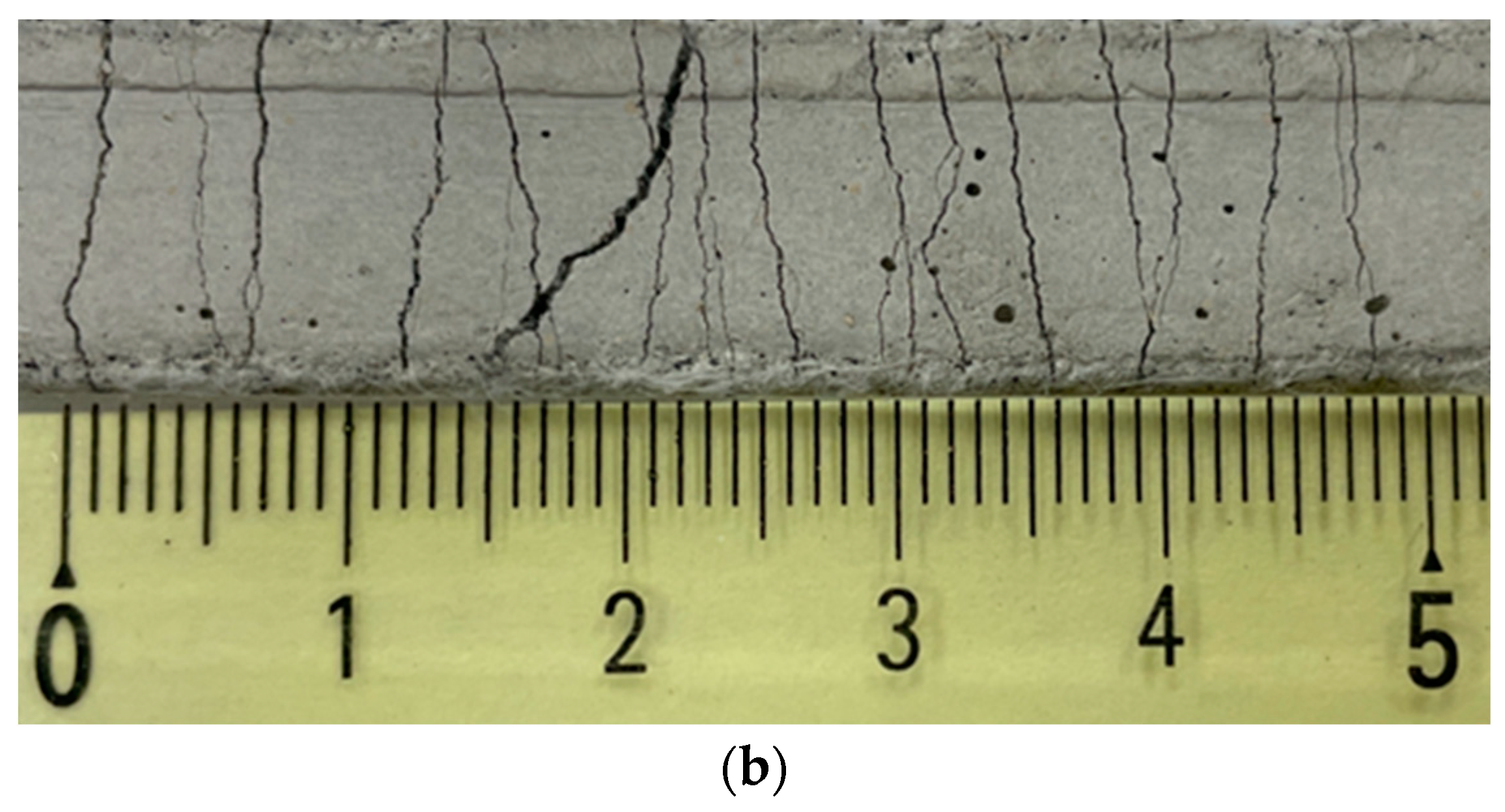
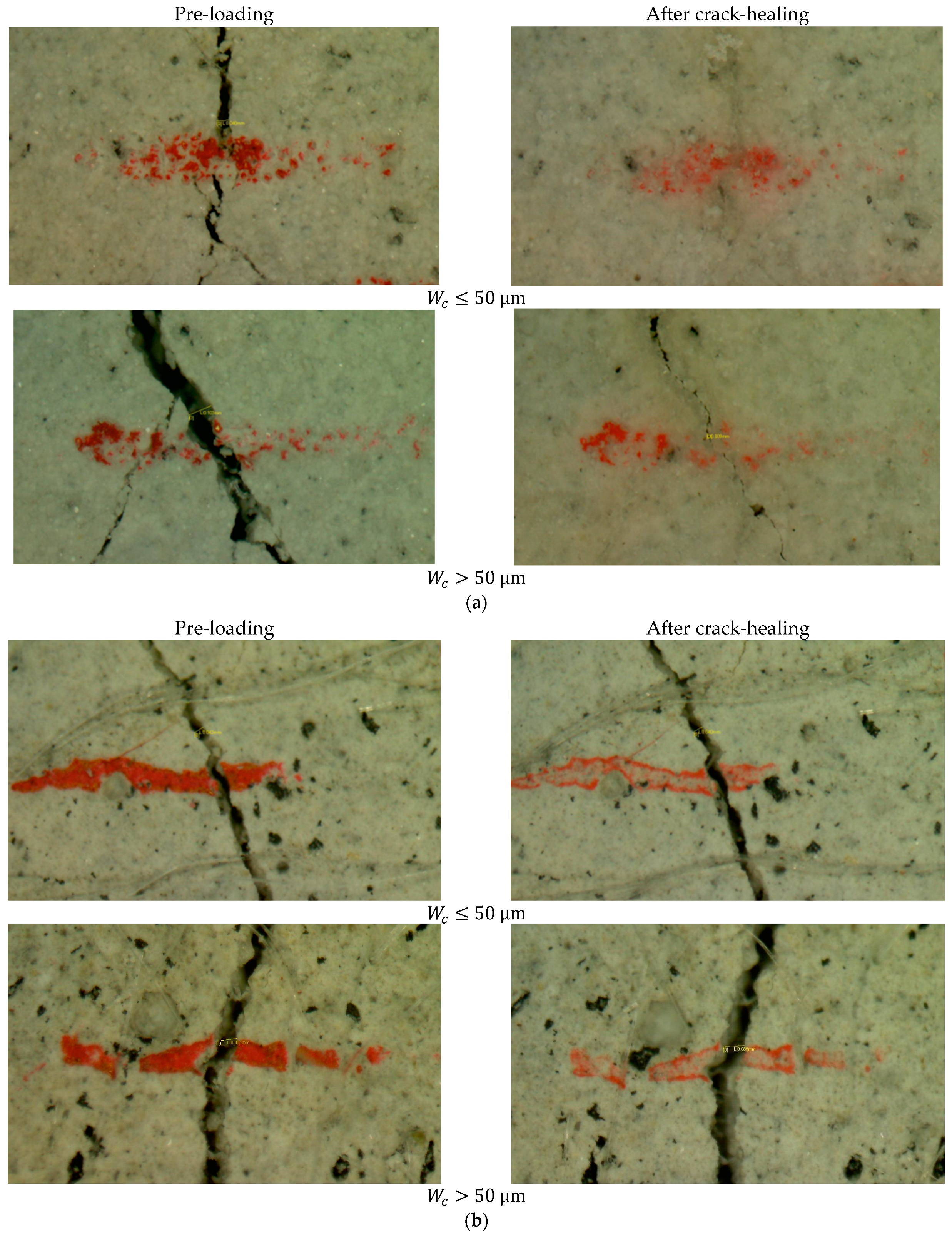
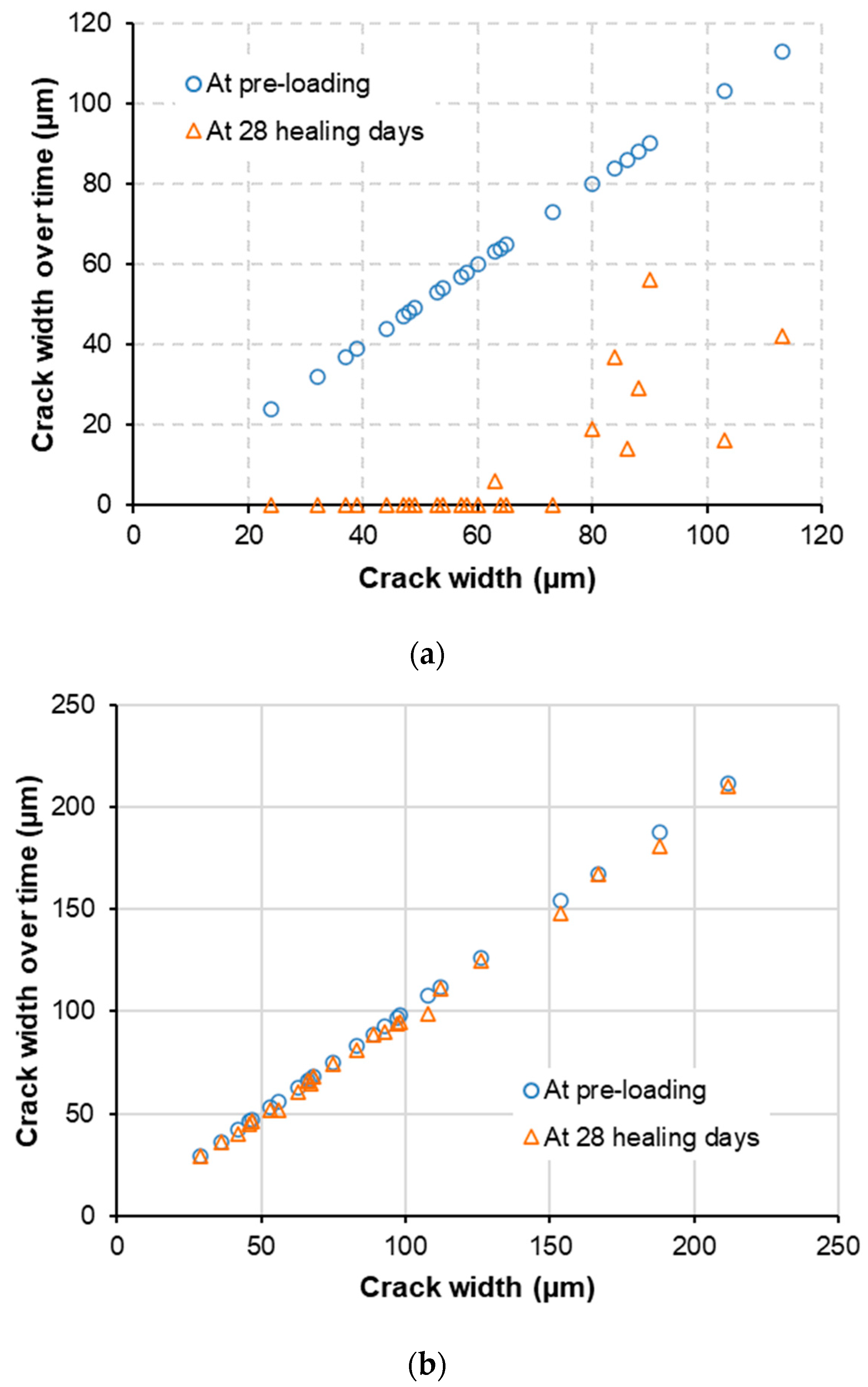

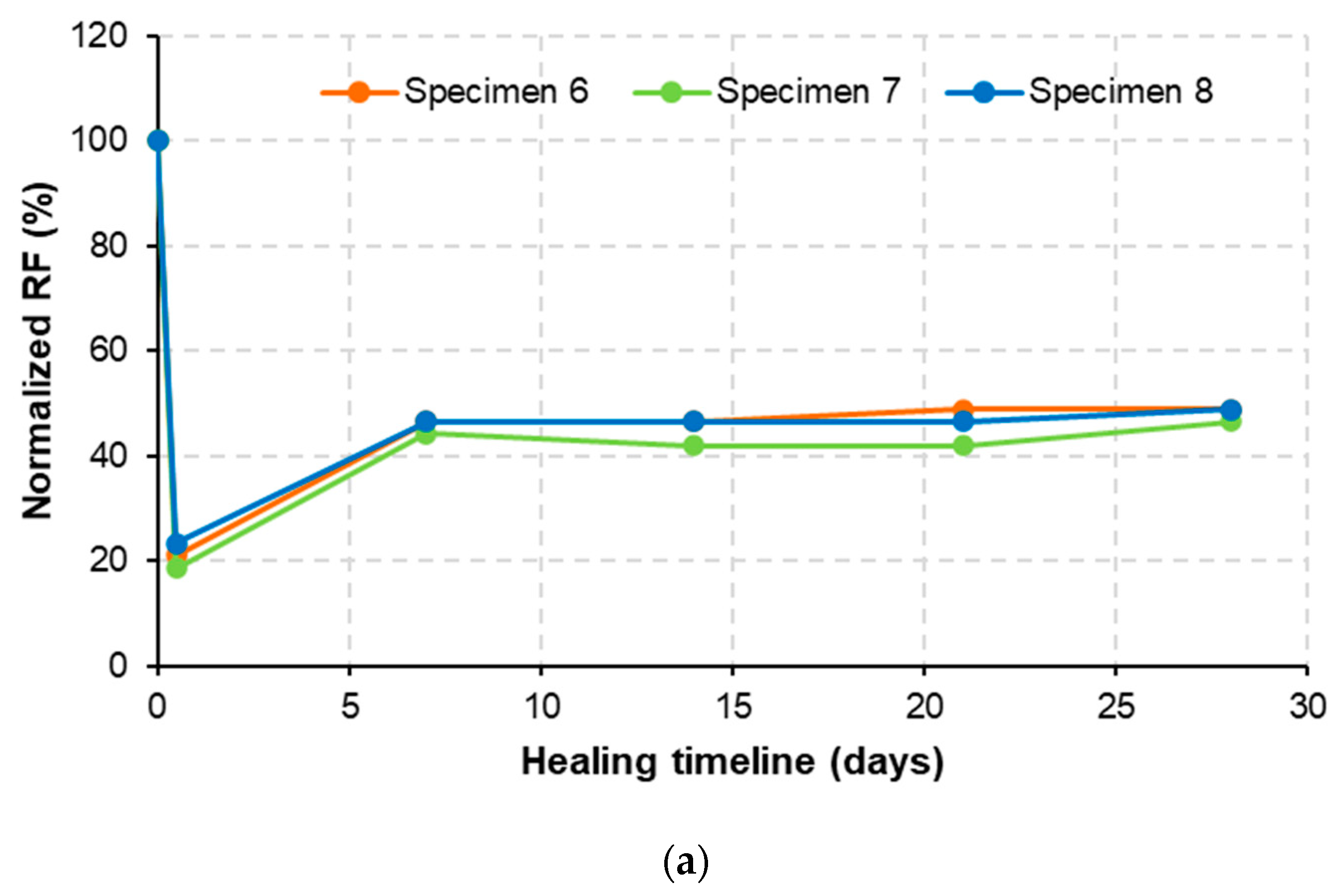
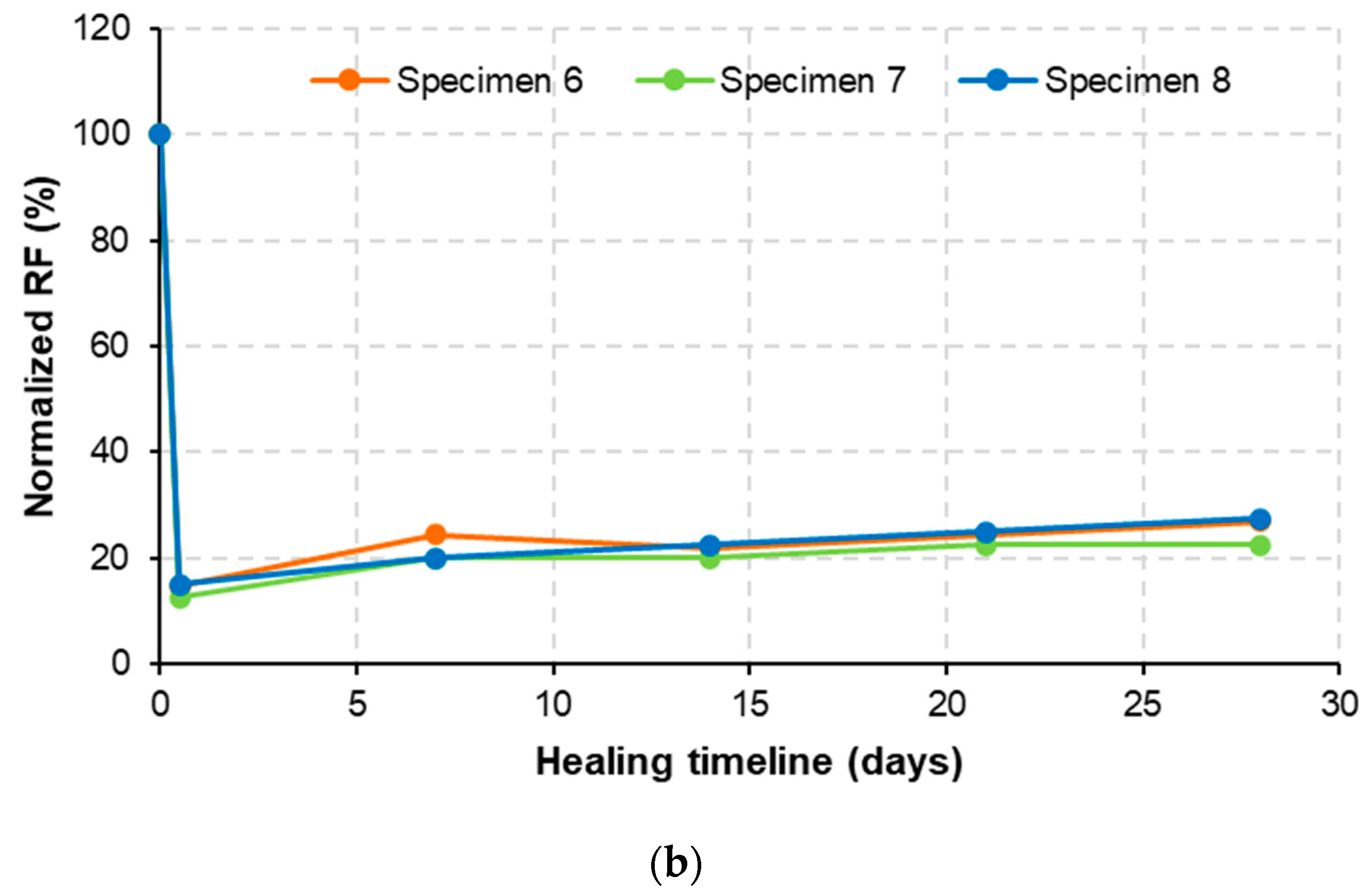
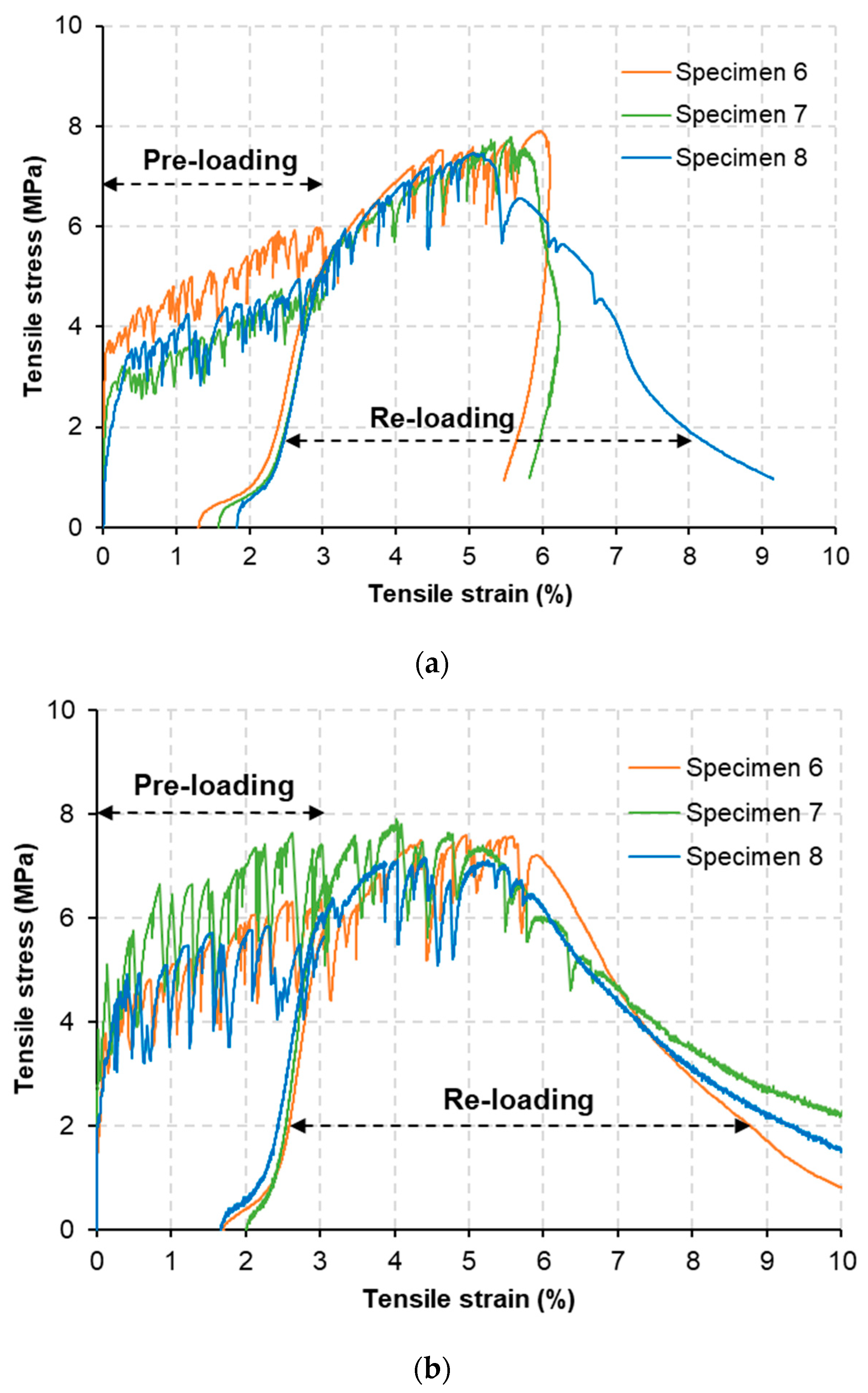

| Materials | SiO2 | Al2O3 | Fe2O3 | CaO | MgO | SO3 | TiO2 | K2O | Na2O | Other |
|---|---|---|---|---|---|---|---|---|---|---|
| Cement | 8.20 | 2.70 | 5.02 | 66.40 | 0.60 | 2.80 | 0.21 | - | 9.10 | 4.97 |
| GGBS | 34.95 | 13.58 | 0.53 | 42.88 | 3.58 | 2.52 | 0.63 | 0.61 | 0.26 | 0.46 |
| Fiber | Length (mm) | Diameter (µm) | Tensile strength (MPa) | Density (g/cm3) | Elastic modulus (GPa) |
|---|---|---|---|---|---|
| PE | 12 | 16 | 2700 | 0.97 | 88 |
| PVA | 8 | 40 | 1560 | 1.30 | 41 |
| Mixture | Binder | Water | CR | SS | EA | SP | VMA | DF | Fiber | Curing | ||
|---|---|---|---|---|---|---|---|---|---|---|---|---|
| Cement | GGBS | PE | PVA | |||||||||
| M-W | 0.5 | 0.5 | 0.4 | 0.1 | 0.5 | 0.05 | 0.002 | 0.001 | 0.001 | 1.25 | 0.1 | U-C |
| M-O | 0.5 | 0.5 | 0.4 | 0.1 | 0.5 | 0.05 | 0.002 | 0.001 | 0.001 | 1.25 | 0.1 | N-C |
| Age (Days) | Days of Rain | Precipitation (mm) | Average Temperature (°C) | Average Relative Humidity (°C) | |
|---|---|---|---|---|---|
| Total | 1-Day (Avg.) | ||||
| 3~28 | 8 | 143 | 5.5 | 28.5 | 75.2 |
| 29~56 | 18 | 274 | 9.8 | 25.5 | 84.3 |
| Mixture | ||||
|---|---|---|---|---|
| M-W | 3.74 ± 0.19 | 7.93 ± 0.62 | 8.00 ± 0.69 | 0.46 |
| M-O | 3.13 ± 0.43 | 7.60 ± 0.31 | 7.74 ± 0.63 | 0.41 |
| Mixture | |||
|---|---|---|---|
| M-W | 67.1 ± 6.0 | 95.6 ± 5.6 | 1.20 ± 0.11 |
| M-O | 41.6 ± 6.6 | 151.2 ± 17.6 | 1.96 ± 0.26 |
| Mixture | ||
|---|---|---|
| M-W | 7.72 ± 0.18 | 5.85 ± 0.13 |
| M-O | 7.54 ± 0.30 | 5.79 ± 0.05 |
Publisher’s Note: MDPI stays neutral with regard to jurisdictional claims in published maps and institutional affiliations. |
© 2022 by the authors. Licensee MDPI, Basel, Switzerland. This article is an open access article distributed under the terms and conditions of the Creative Commons Attribution (CC BY) license (https://creativecommons.org/licenses/by/4.0/).
Share and Cite
Park, S.-E.; Nguyễn, H.H.; Choi, J.-I.; Lee, B.Y.; Kim, Y.Y. Comparison of Mechanical and Crack-Healing Properties of PE-PVA Hybrid Fiber-Reinforced SHCCs in Natural and Underwater Conditions. Materials 2022, 15, 6339. https://doi.org/10.3390/ma15186339
Park S-E, Nguyễn HH, Choi J-I, Lee BY, Kim YY. Comparison of Mechanical and Crack-Healing Properties of PE-PVA Hybrid Fiber-Reinforced SHCCs in Natural and Underwater Conditions. Materials. 2022; 15(18):6339. https://doi.org/10.3390/ma15186339
Chicago/Turabian StylePark, Se-Eon, Huy Hoàng Nguyễn, Jeong-Il Choi, Bang Yeon Lee, and Yun Yong Kim. 2022. "Comparison of Mechanical and Crack-Healing Properties of PE-PVA Hybrid Fiber-Reinforced SHCCs in Natural and Underwater Conditions" Materials 15, no. 18: 6339. https://doi.org/10.3390/ma15186339
APA StylePark, S.-E., Nguyễn, H. H., Choi, J.-I., Lee, B. Y., & Kim, Y. Y. (2022). Comparison of Mechanical and Crack-Healing Properties of PE-PVA Hybrid Fiber-Reinforced SHCCs in Natural and Underwater Conditions. Materials, 15(18), 6339. https://doi.org/10.3390/ma15186339







